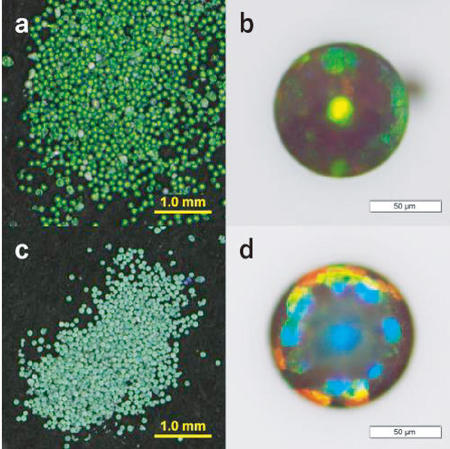Photonic Ball
Photonic crystals are materials whose refractive index changes at a period of about the wavelength of light and are studied as being usable as "semiconductors of light". In recent years, photonic crystals with a photonic band gap in the visible light region can be constructed by utilizing a self-assemble method of colloidal particles, and are also attracting attention as materials for manipulating colors.
We can control the geometrical shape of photonic crystals consisting of colloidal particles, and can produce spherical photonic crystals 1) -4). This spherical photonic crystal is called a photonic ball, and exhibits an optical phenomenon depending on the particle size of the colloidal particles. The right figure shows macroscopic and microscopic color development of a photonic ball formed from silica colloidal particles of 250 nm (a, b) and 400 nm (c, d) in particle diameter. Both systems appear macroscopically green, but microscopically exhibit quite different structural color properties. It has been found that the color produced by photonic balls consisting of 250 nm colloidal particles can be explained by Bragg reflection. On the other hand, only the grating diffraction or the Bragg reflection has been considered separately in the previous researches for the explanation of the iridescent coloring phenomenon as seen from the photonic ball consisting of 400 nm colloidal particles.
Here, Ohnuki et al. successfully described both microscopic iridescence and macroscopic green by combining the mechanisms of both Bragg reflection and grating diffraction. Furthermore, from the spherical symmetry of the crystal, they also explained that the hue by macroscopic observation hardly depends on the observation direction. Such photonic balls may become available as pigments utilizing structural colors.
1) N. Vogel et al., PNAS, 2008, 20, 4263.
2) M. Teshima et al., J. Mater. Chem. C., 2015, 3, 769.
3) M. Sakai et al., Small, 2018, 14, 1800817.
4) R. Ohnuki et al., Adv. Opt. Mater, 2019, 7, 1900227.
Yukikazu Takeoka,Nagoya University
